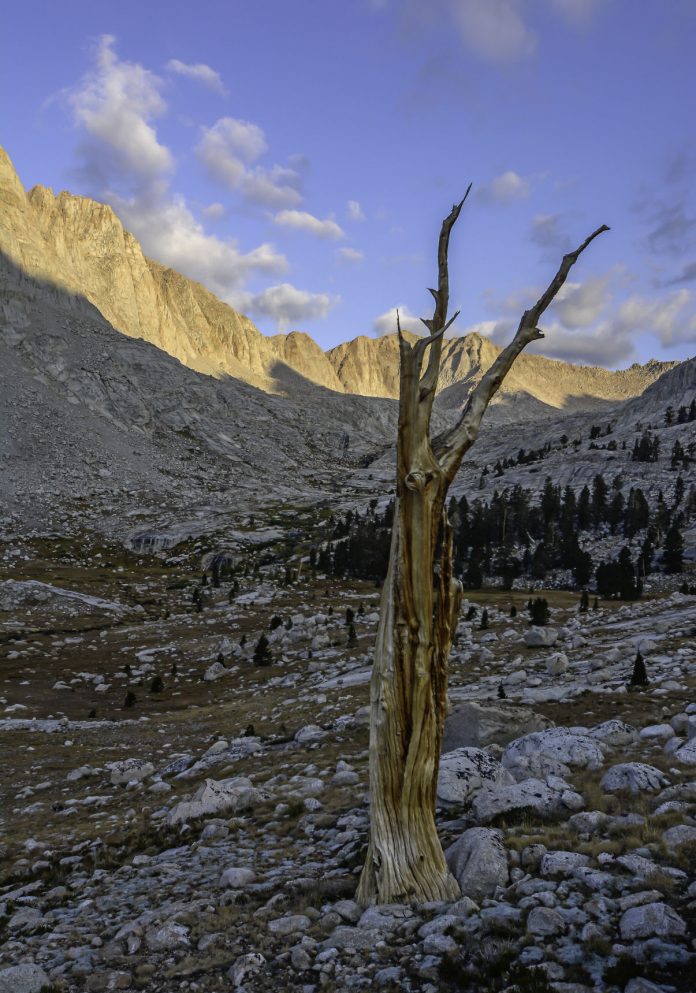It was day two. Deep in the wilderness of Sequoia National Park, we stood with a ranger on the small entry porch of her backcountry cabin looking down at a map discussing alternatives to our original itinerary.
The day before, we had shouldered our packs at Horseshoe Meadows (9,960 feet) and chugged up and over Cottonwood Pass (11,130 feet). We shuffled past Chicken Spring Lake intent on reaching the next water source we could see on the map—an unnamed mountain lake cradled in a cirque.
When we reached the spot on the trail beneath where the lake was surely poised above, we could find no outlet creek. Behind us or ahead of us, water was a long way off, so I went up the hill to investigate. Dry. Bone dry. Not even a muddy mire remained at the bottom of the lake basin.
Fortunately, a member of our party found a meek trickle of water hidden in the dry brown meadow below the trail. Thank goodness. We had water for the evening.
The next day, when we met with the ranger at Rock Creek, it was clear water would be problem along our route. She told us that the creek where we planned to camp that night was dry as well. What to do?
Miter Basin has a reputation for spectacular scenery. While it is the last gasp of the very highest Sierra, as Phil Arnot says, “it is no fade away … but a mighty visual crescendo.” On that backcountry cabin porch, we pondered Miter Basin as an alternative destination.
Water would be no problem. It was 1,500 feet above us, but only six miles away—an easy day’s journey. Once there, we could establish a base camp, shed our large packs and explore the basin lightly burdened.
Day three. We ascended the trail along Rock Creek regaining elevation surrendered the day before. After a snack at lovely Rock Creek Lake, we found the unmaintained “use trail” that followed Rock Creek to the entrance to Miter Basin. When the effort allowed us to look up from our shoe tops, we gasped at massive monolithic granite walls beginning to appear beside us—a hint of what was to come.
As if carefully staged for dramatic effect, Miter Basin appeared with staggering suddenness as we crested the brow of the hill. No dictionary of superlatives, no digital camera sensor could possibly capture the impressive scale and beauty of what opened before us.
Straight ahead, a huge valley reached for out for a perfectly level mile. Beyond, and along both sides, sheer granite walls punctuated by a half dozen peaks over 13,000 feet wrapped the basin. Other than low-lying alpine plants and a few foxtail pines, it was a sculpture of pure rose-hued granite. Some might call it barren, but it was beautiful and it beckoned.
Over the next two days, we explored the high mountain lakes cradled in the basin’s recesses. Sky Blue Lake (11,545 feet) rested behind the first glacial step above us. Beyond, we climbed a succession of steps to beautiful hidden lakes above 12,000 feet.
But the enchantment of time spent in a place like Miter Basin is more than just spectacular scenery. Rising early for the first touch of morning light on the peaks; listening to the songs of coyote packs reverberate and echo throughout the valley; discovering mosaics of ground-hugging alpine plants tinged with fall colors; finding peak reflections in the still pools on the valley floor—all of this and much more awaits in Miter Basin.
Ron Erskine is a local outdoors columnist and avid hiker. Visit him online at RonErskine.com, his blog at WeeklyTramp.com or email him at ro********@*sn.com.










